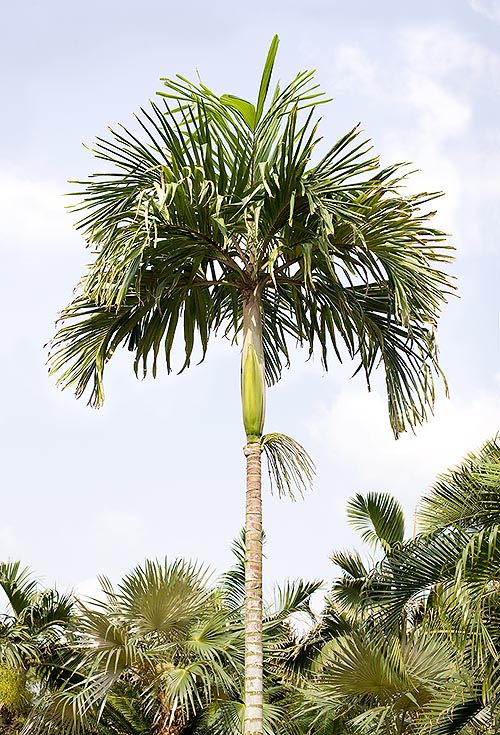Family : Arecaceae

Text © Pietro Puccio

English translation by Mario Beltramini

The Hydriastele beguinii is a 7 m tropical palm, cultivable in pot too © Giuseppe Mazza
The name of the genus is the combination of the Greek words “hydor” = water and “stele” = upright stone fixed firmly in the soil, with probable reference to the swampy habitat where some plants belonging to this genus live; the species is honoured to the Dutch botanist Victor Beguin (1886-1943).
Common names: hydria palm tree, Moluccan umbrella palm, umbrella palm (English); palmeira sifoquêntia (portuguese-Brazil).
The Hydriastele beguinii (Burret) W.J.Baker & Loo (2004) is a monoecious plant with single stem, erect, up to about 7 m tall with a diameter of 6-10 cm, of dark green colour and on which stand out the rings trace of the junction of the fallen leaves.
The leaves are pinnate, arcuate, about 1,8 m long; the pinnulae have a variable form, from linear-lanceolate to rhomboidal, of an intense glossy green colour on the upper side, opaque below, pleated and toothed at the apex, with the two terminal pinnulae much broader; the young plants have entire leaves or divided in few wide segments.
The foliar sheath, tubular, slightly swollen at the base, of green colour and covered by a thin waxy coat, wraps the stem for a length of approximately 60 cm.
The inflorescences bear under the leaves on a short peduncle, are ramified, with cream white flowers disposed in the typical triad (a female flower between two male ones).
The fruits, containing one seed only, are oblong, about 1,4 cm long and with a diameter of 0,7 cm, red when ripe. It reproduces by seed which germinates in 3-4 months at the temperature of 24-26 °C.
The growth is moderately fast. It is a plant with remarkable ornamental characteristics, to be utilized isolated or in groups at the shade of great trees exclusively in tropical and humid subtropical climate zones, on soils rich of organic substance, draining, and kept constantly humid; suitable also, due to its contained dimensions, for small shady gardens. The adult plants may stand exceptional, and very short lasting, decreases of temperature around the 0 °C, but not the very long periods of medium-low temperatures met in the winter times in the warm temperate zones.
The young plants, with their entire or little divided leaves of bright green colour, are an ideal subject, even if little diffused, as pot plant for the decoration of patios, greenhouses, winter gardens, and spacious luminous interiors, utilizing substrata rich in humus with addition of coarse sand, agriperlite or other inert substance around the 30%, in order to improve the drainage. The watering must be regular during the whole year and the temperatures are to be maintained over the 16 °C.
Synonyms: Siphokentia beguinii Burret (1927); Siphokentia pachypus Burret (1927).
→ For general notions about ARECACEAE please click here.
